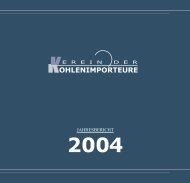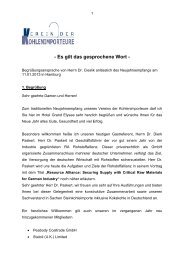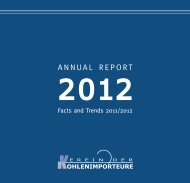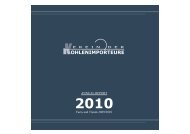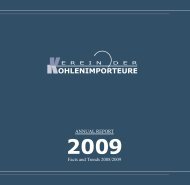Annual Report 2010 - Verein der Kohlenimporteure eV
Annual Report 2010 - Verein der Kohlenimporteure eV
Annual Report 2010 - Verein der Kohlenimporteure eV
You also want an ePaper? Increase the reach of your titles
YUMPU automatically turns print PDFs into web optimized ePapers that Google loves.
This is what happened during the year:<br />
Development of Energy Prices in <strong>2010</strong><br />
01.01.<strong>2010</strong> 01.07.<strong>2010</strong> 31.12.<strong>2010</strong><br />
EUR/tce EUR/tce EUR/tce<br />
Heavy Fuel Oil (HFO) 255 276 287<br />
Natural Gas / Power<br />
Plants<br />
227 242 248<br />
Import Coal Price cif<br />
ARA (spot market)<br />
HT-D13<br />
81 85 104<br />
<br />
recovered significantly over the course of <strong>2010</strong>. Natural<br />
gas prices continued to deteriorate, but then recovered<br />
during the second half of the year. In particular, an<br />
abundant supply of LNG on the world market led to<br />
volatile prices on spot markets.<br />
In all market situations, import coal enjoyed a major<br />
competitive advantage in <strong>2010</strong> that diminished with<br />
respect to natural gas, because coal prices tightened<br />
sharply towards the end of the year.<br />
Energy Price Development as a Yearly<br />
Average<br />
2009/<strong>2010</strong><br />
2008 2009 <strong>2010</strong> Change<br />
€/tce %<br />
Heavy Fuel Oil (HFO) 275 208 270 29.8<br />
Natural Gas / Power Plants 1) Cross-Bor<strong>der</strong> Price/Import<br />
269 246 233 - 5.3<br />
Coal 112 79 85 7.6<br />
1) <br />
<br />
HT-D14<br />
<br />
natural gas developed on the basis of the above values<br />
as shown below:<br />
Price Advantages of Imported Coal<br />
2008<br />
€/tce<br />
2009<br />
€/tce<br />
<strong>2010</strong><br />
€/tce<br />
Import Coal versus HFO 163 129 185<br />
Import Coal versus Gas<br />
HT-D15<br />
157 167 148<br />
Imported hard coal was able to maintain a significant<br />
<br />
<br />
<br />
Development of Energy Prices<br />
free Power Station<br />
euro/TCE<br />
320<br />
280<br />
240<br />
200<br />
160<br />
120<br />
80<br />
40<br />
0<br />
/08<br />
Steam Coal Fuel Oil Heavy Gas<br />
Figure 21 Sources: Statistik <strong>der</strong> Kohlenwirtschaft- Gas preliminary, BAFA ,<br />
own calculation<br />
s<br />
Prices for steam coal and coke are in line with shortterm<br />
market trends. Coking coal prices are generally<br />
negotiated annually and price increases/decreases<br />
appeared in the cross-bor<strong>der</strong> prices after a certain delay<br />
during the year. In <strong>2010</strong>, a major change occurred.<br />
Large players on the market announced at relatively<br />
short notice that in future only quarterly prices would be<br />
agreed. Other coking coal exporters followed, although<br />
some, above all American companies, continue to offer<br />
yearly prices. The aim of quarterly pricing is to reflect<br />
more quickly the market situation as well as to push<br />
coking coal as a “commodity” and thus enable the use of<br />
financial products to secure prices. This change was and<br />
is a major problem for the steel industry, because it trades<br />
with its customers using yearly prices and it would be<br />
43



